
Eisenach is a town in Thuringia, Germany with 42,000 inhabitants, located 50 kilometres west of Erfurt, 70 km southeast of Kassel and 150 km northeast of Frankfurt. It is the main urban centre of western Thuringia and bordering northeastern Hessian regions, situated near the former Inner German border. A major attraction is Wartburg castle, which has been a UNESCO World Heritage Site since 1999.

The Wartburg is a castle originally built in the Middle Ages. It is situated on a precipice of 410 metres (1,350 ft) to the southwest of and overlooking the town of Eisenach, in the state of Thuringia, Germany. It was the home of St. Elisabeth of Hungary, the place where Martin Luther translated the New Testament of the Bible into German, the site of the Wartburg festival of 1817 and the supposed setting for the possibly legendary Sängerkrieg. It was an important inspiration for Ludwig II when he decided to build Neuschwanstein Castle.

Henry Raspe was the Landgrave of Thuringia from 1231 until 1239 and again from 1241 until his death. In 1246, with the support of the Papacy, he was elected King of Germany in opposition to Conrad IV, but his contested reign lasted a mere nine months.
Wartburgkreis is a Kreis (district) in the west of Thuringia, Germany. Neighboring districts are the districts Unstrut-Hainich-Kreis, Gotha, Schmalkalden-Meiningen, and the districts Fulda, Hersfeld-Rotenburg and Werra-Meißner-Kreis in Hesse. The district has 30 municipalities, including Eisenach.
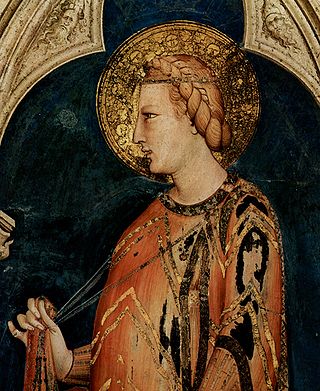
Elizabeth of Hungary, also known as Elisabeth of Thuringia, was a princess of the Kingdom of Hungary and the landgravine of Thuringia.

Saxe-Weimar-Eisenach was a German state, created as a duchy in 1809 by the merger of the Ernestine duchies of Saxe-Weimar and Saxe-Eisenach, which had been in personal union since 1741. It was raised to a grand duchy in 1815 by resolution of the Congress of Vienna. In 1903, it officially changed its name to the Grand Duchy of Saxony, but this name was rarely used. The grand duchy came to an end in the German Revolution of 1918–19 with the other monarchies of the German Empire. It was succeeded by the Free State of Saxe-Weimar-Eisenach, which was merged into the new Free State of Thuringia two years later.

Schmalkalden is a town in the Schmalkalden-Meiningen district, in the southwest of the state of Thuringia, Germany. It is on the southern slope of the Thuringian Forest at the Schmalkalde river, a tributary to the Werra. As of 31 December 2022, the town had a population of 20,065.

Henry III, called Henry the Illustrious from the House of Wettin was Margrave of Meissen and last Margrave of Lusatia from 1221 until his death; from 1242 also Landgrave of Thuringia.
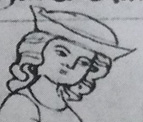
Louis IV the Saint, a member of the Ludovingian dynasty, was Landgrave of Thuringia and Saxon Count palatine from 1217 until his death. He was the husband of Elizabeth of Hungary.

Freyburg is a town in the Burgenlandkreis district, in Saxony-Anhalt, Germany. It is situated on the river Unstrut, 9 km northwest of Hanseatic Naumburg, 63 km from Leipzig and 231 km from Berlin. It is part of the Verwaltungsgemeinschaft Unstruttal. On 1 July 2009 it absorbed the former municipalities Pödelist, Schleberoda, Weischütz and Zeuchfeld. Freyburg consists of the Ortsteile (divisions) Dobichau, Freyburg, Nißmitz, Pödelist, Schleberoda, Weischütz, Zeuchfeld and Zscheiplitz.
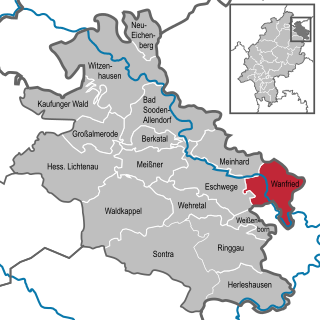
Wanfried is a town in the Werra-Meißner-Kreis in northeasternmost Hesse, Germany. It is classified as a Landstadt, a designation given in Germany to a municipality that is officially a town (Stadt), but whose population is below 5,000. It literally means “country town”.

Herleshausen is a municipality in the Werra-Meißner-Kreis in Hesse, Germany.

The Ludovingians or Ludowingians were the ruling dynasty of Thuringia and Hesse during the 11th to 13th centuries.
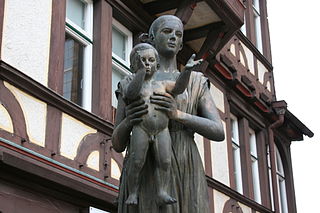
Sophie of Thuringia was the second wife and only Duchess consort of Henry II, Duke of Brabant and Lothier. She was the heiress of Hesse which she passed on to her son, Henry upon her retention of the territory following her partial victory in the War of the Thuringian Succession in which she was one of the belligerents. Sophie was the founder of the Brabant dynasty of Hesse.
The Duchy of Thuringia was an eastern frontier march of the Merovingian kingdom of Austrasia, established about 631 by King Dagobert I after his troops had been defeated by the forces of the Slavic confederation of Samo at the Battle of Wogastisburg. It was recreated in the Carolingian Empire and its dukes were appointed by the king until it was absorbed by the Saxon dukes in 908. From about 1111/12 the territory was ruled by the Landgraves of Thuringia as Princes of the Holy Roman Empire. When Frederick IV, the last independent ruler of Thuringia died in 1440, the territory passed to his nephew, the Saxon elector Frederick II.

Ludwig II, Landgrave of Thuringia, nicknamed Louis the Iron.
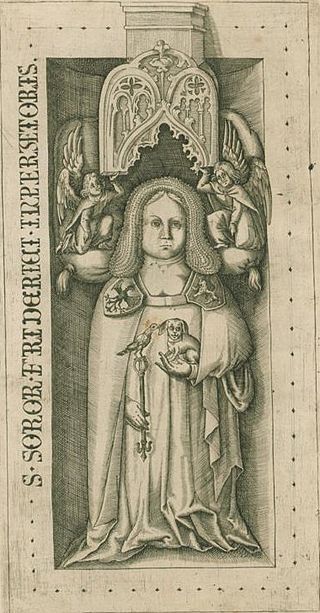
Judith of Hohenstaufen, also known as Judith of Hohenstaufen or Judith of Swabia, a member of the Hohenstaufen dynasty, was Landgravine of Thuringia from 1150 until 1172 by her marriage with the Ludovingian landgrave Louis II. She was baptized as Judith, but was commonly called Jutta or Guta. Sometimes the Latinate form Clementia was used, or Claritia or Claricia.

Eisenach Charterhouse is a former charterhouse, or Carthusian monastery, in Eisenach in Thüringia, Germany, founded in 1378 and suppressed in 1525.
The Brabant Road, Cologne to Leipzig Road or Liege Road is an ancient road which, during the Middle Ages and Early Modern Period, was one of the most important continental east-west oriented military and trade routes. It ran from the eponymous Duchy of Brabant to Leipzig.
Hermann Hahn was a German architect. Hahn lived and worked in Eisenach, where he reached importance, particularly through his plans (designs) of numerous completed villas in Eisenach's south quarter. These mansion districts were established on the hillsides of Mariental valley in the construction boom between 1850 and 1914.























